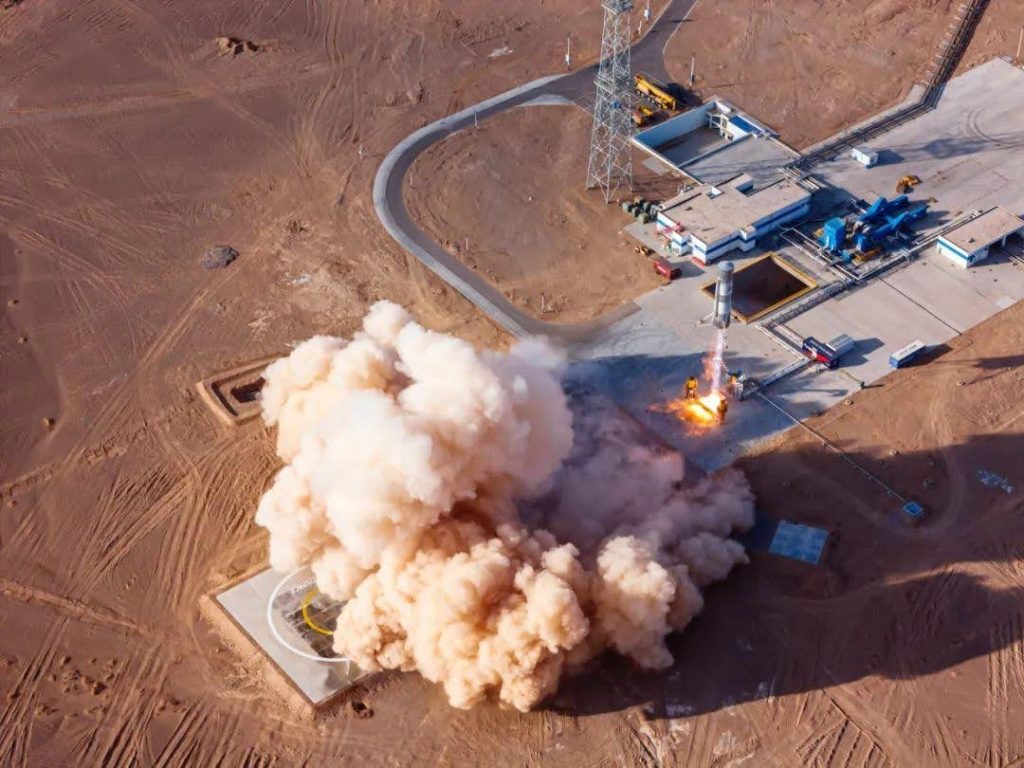FLASHFORGE 3D Printer AD5M, CoreXY 600mm/s High-Speed Printer with 1-Click Auto Leveling, High-Temp Direct Drive Extruder, 3s Quick-Swap Nozzle, 220×220×220mm Build Volume
$259.00 (as of June 19, 2025 23:45 GMT +00:00 - More infoProduct prices and availability are accurate as of the date/time indicated and are subject to change. Any price and availability information displayed on [relevant Amazon Site(s), as applicable] at the time of purchase will apply to the purchase of this product.)You won’t believe what LandSpace, a private Chinese space company, has achieved! They have just made history by successfully conducting the first test launch and landing of their reusable Zhuque-3 VTVL-1 rocket. This groundbreaking achievement marks a significant milestone in the future of space exploration. The rocket reached an impressive altitude of around 350 meters before gracefully landing back down on a designated area. What makes this even more intriguing is the pivotal role played by Bright Laser Technologies (BLT) in the rocket’s production. Using their cutting-edge metal 3D printing technology, BLT was able to manufacture various components, significantly reducing production time, expediting deliveries, and supporting rapid development iterations. This exceptional feat not only validates the rocket’s control system but also showcases the remarkable accuracy of its guidance and control system, along with the reliable performance of the rocket’s soft landing cushioning mechanism. Powered by a powerful Tianque-12 methalox engine, the rocket is now set to undergo further testing to verify its key components. LandSpace’s ultimate goal is to achieve a full launch of the Zhuque-3 VTVL-1 in 2025, propelling us into a future of extraordinary space exploration possibilities.
LandSpace successfully conducts test launch and landing of reusable Zhuque-3 VTVL-1 rocket
Private Chinese space company, LandSpace, has made a significant breakthrough in rocket technology with the successful test launch and landing of its reusable Zhuque-3 VTVL-1 rocket. This milestone achievement marks a major step forward in the field of aerospace innovation and firmly establishes LandSpace as a key player in the global space industry.
Rocket reaches an altitude of 350 meters
During the test launch, the Zhuque-3 VTVL-1 rocket reached an impressive altitude of approximately 350 meters. This successful ascent showcased the rocket’s powerful propulsion system and demonstrated its capability to reach the necessary altitude for various space missions.
Rocket lands back on a designated area
One of the most remarkable aspects of this test launch was the rocket’s ability to land back on a pre-designated area. The precise landing showcased the accuracy and efficiency of the rocket’s guidance and control systems. This achievement brings us one step closer to realizing the dream of reusable space vehicles, which would significantly reduce the cost and environmental impact of space exploration.

Bright Laser Technologies’ role in production
Bright Laser Technologies (BLT) played an integral role in the production of the Zhuque-3 VTVL-1 rocket. Leveraging their expertise in metal 3D printing technology, BLT manufactured various components for the rocket. This collaboration between LandSpace and BLT highlights the importance of innovative manufacturing techniques in the advancement of space technology.
BLT uses metal 3D printing technology
BLT’s use of metal 3D printing technology allowed LandSpace to achieve significant advantages in the production process. By employing this cutting-edge technique, BLT was able to reduce production time, expedite deliveries, and support rapid development iterations. This not only enhanced the efficiency of the production process but also allowed for greater flexibility in design modifications.

Benefits of BLT’s 3D printing technology
The utilization of BLT’s metal 3D printing technology brought several benefits to the production of the Zhuque-3 VTVL-1 rocket. Firstly, it enabled the creation of complex geometries and intricate structures that would have been difficult or impossible to manufacture using traditional methods. This capability allows for the optimization of component performance and overall rocket efficiency.
Furthermore, 3D printing allows for the production of lightweight components without compromising on strength or durability. This not only reduces the overall weight of the rocket but also improves fuel efficiency and payload capacity. Additionally, the increased design freedom provided by 3D printing allows for the integration of multiple components into a single part, reducing the complexity of the rocket’s assembly process.
Validation of rocket’s control system
The successful recovery test of the Zhuque-3 VTVL-1 rocket provided a valuable opportunity to validate the integrity and compatibility of the rocket’s control system. The control system, responsible for guiding and maneuvering the rocket, demonstrated exceptional performance throughout the test launch. This validation is crucial in ensuring the rocket’s reliability and safety during future missions.

Accuracy of the guidance and control system
The accuracy of the guidance and control system during the test launch was of utmost importance. The successful landing on a pre-designated area showcased the precision and reliability of the rocket’s guidance system. This remarkable achievement highlights the advancements made in the control systems of modern rockets, setting new standards for future space missions.
Reliable performance of the soft landing cushioning mechanism
Critical to the success of a reusable rocket is a reliable soft landing cushioning mechanism. The Zhuque-3 VTVL-1 rocket demonstrated its ability to land smoothly without compromising the structural integrity of the spacecraft. The cushioning mechanism absorbed the impact of landing, ensuring the safety of the rocket and facilitating its future reuse.

Power source of the Zhuque-3 VTVL-1
The power source of the Zhuque-3 VTVL-1 rocket was the Tianque-12 methalox engine. This engine, designed and developed by LandSpace, incorporates advanced technology to provide efficient and reliable thrust. The choice of the Tianque-12 engine demonstrates LandSpace’s commitment to developing high-performance propulsion systems for next-generation rockets.
Future testing and development plans
With the successful test launch and landing of the Zhuque-3 VTVL-1 rocket, LandSpace is now focused on further testing and development of key components. The company plans to conduct rigorous tests to verify the performance and reliability of the rocket’s systems. These tests will provide valuable insights and data to optimize the design and performance of the rocket.
Looking ahead, LandSpace aims to achieve its first full launch of the Zhuque-3 VTVL-1 rocket in 2025. This ambitious goal sets the stage for a new era in space exploration, where reusable rockets become the norm and space missions become more accessible and sustainable. LandSpace’s innovative approach to rocket technology has the potential to revolutionize the space industry, opening up a world of possibilities for future space exploration and scientific discovery.











